The collision of Chengdu and Xi'an ~ A journey of food and culture ~2 cities will take you to experience the world in my eyes on the 9th
[Write before traveling]
I went to Chengdu and Xi'an for the second time, and I had a lot of insights and insights. This time, I traveled with my husband, father-in-law, and mother-in-law. Many itineraries and arrangements were restrained.

[Transportation]
Harbin--Chengdu October 26, 2019 Aircraft CZ6255 8:50-13:20 1000 yuan/person
Xipu, Chengdu--Dujiangyan Lidui Park October 27, 2019 Intercity C6083 8:21-8:49 10 yuan/person
Dujiangyan Lidui Park--Chengdu Xipu October 27, 2019 Intercity C6092 16:24-16:58 10 yuan/person
Chengdu--Leshan October 29, 2019 Intercity C6351 9:06-9:58 54 yuan/person
Leshan--Chengdu October 29, 2019 Intercity C6270 17:17-18:27 54 yuan/person
Chengdu--Xi'an October 30, 2019 High-speed Railway G308 10:42-14:37 263 yuan/person
Xi'an-Harbin November 3, 2019 Aircraft JR1475 17:25-20:15 483 yuan/person
[Accommodation]
Chengdu
Tujia APP: [Seclusion] Kuanzhai Alley B & B (Address: Tonghuimen Jindu Phase 1) 320 yuan/per stay
Xi'an
Tujia APP: Xi'an Internet Celebrity Terracotta Warriors B & Bs (Address: Hongcheng International Apartment) 382/per night
These two B & Bs have 3 bedrooms, 2 living rooms and 2 bathrooms. It is more than enough for the four of us. It is still a bit cold when we come at the end of October.
[Cost]
Four people are the best travel, and accommodation, taxis and meals are the most suitable
[Clothing]
Chengdu is not cold. Above 10℃, sports shoes will do. Xi'an is slightly colder and it is still raining, so you can wear a thin down jacket.
[Trip]
The first day [October 26] Wuhou Temple in Chengdu-Jinli (Shujiuxiang Hotpot)
The next day [October 27] Dujiangyan, Chengdu (private kitchen beside the city wall)
Day 3 [October 28] Chengdu Giant Panda Breeding Base-Chunxi Road IFS-Qingyang Palace (Jiujiu Fresh Pot Vegetables)
Day 4 [October 29] Leshan, Chengdu-Kuanzhai Alley (Feng Sannian's Beef with Stepping Feet)
Day 5 [October 30] Xi'an Sa Jinqiao-Hui Street
Day 6 [October 31] Xi'an Shaanxi History Museum (Biangbiang, Gongjia Courtyard)
Day 7 [November 1] Xi'an Terracotta Warriors and Horses-Gaojia Courtyard (Mother's Cuisine in Southern Shaanxi)
Day 8 [November 2] Xi'an Little Wild Goose Pagoda-Xi'an Museum-Yongning Gate City Wall (Zhangji Roujiamo on Ziwu Road, Chang 'an)
Day 9 [November 3] Return to Harbin
The first day [October 26] Wuhou Temple in Chengdu-Jinli (Shujiuxiang Hotpot)

I boarded the plane at 8:05 today and took off after de-icing. I flew for more than 4 hours. I didn't expect to meet my classmate from driving school on the plane. She was a flight attendant on such a plane. The world is really a very small place. Chengdu today is 13℃ and it is raining lightly. After getting off the plane, I take a taxi for 60 yuan to Tonghuimen B & B.

This community was the place I lived in when I came to Chengdu for the Chinese New Year in 2018. The location is too convenient. It is close to the wide and narrow alleys. There is a big supermarket and subway downstairs. It is very convenient to go anywhere. I still booked this community this time. The boss sent me an access card and checked in smoothly.
After cleaning up, I went straight to Shujiuxiang to eat hot pot. Coming to Chengdu in 2018, the Shujiuxiang really left a good impression on me. It was really delicious and delicious ~
It wasn't long to walk from the B & B to Shujiuxiang. Just in time to turn around the city and walk to Baihuatan Park.









Although it was raining lightly, the green in your eyes made people feel really comfortable. After a casual stroll in the park, you would arrive at the Shujiuxiang Baihua Flower Shop.

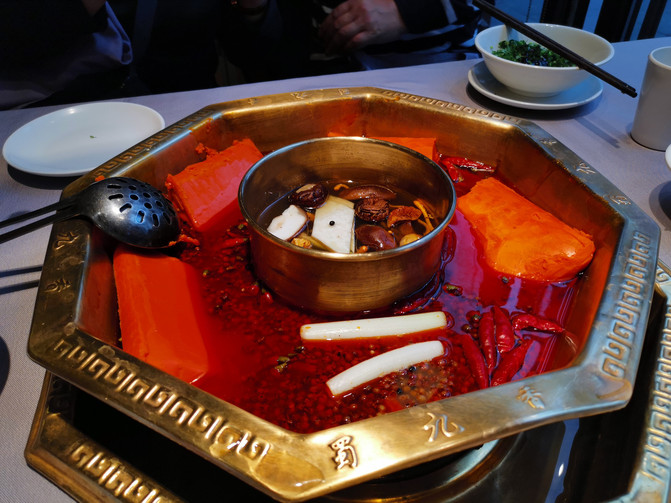




There are still many things that haven't been photographed. Crispy meat, yellow throat, duck sausage, bamboo shoots, etc. are really delicious. How can I eat less hot pot when I arrive in Chengdu ~

After eating, it was only after 6 p.m., so I took a taxi to the Wuhou Temple to take a look. The Wuhou Temple closed at 20 o'clock. Ticket sales stopped 1 hour before the museum closed. I rushed in before the museum closed and experienced the different Wuhou Temple. The ticket price is 50 yuan, half price for students, and free for police. It is worthy of praise ~
The Wuhou Temple commemorates Zhuge Liang, the prime minister of Shu during the Three Kingdoms period. When it was first built, it was adjacent to the temple of Emperor Zhaolie Liu Bei. In the early years of the Ming Dynasty, it was merged into the Zhaolie Temple of the Han Dynasty, becoming the only temple in China where monarch and minister worshiped together. The cultural relics area of Wuhou Temple in Chengdu mainly consists of Huiling, Han Zhaolie Temple, Wuhou Temple, Sanyi Temple, etc. The main building is Wuhou Temple.



The last time I came here was during the day, but I didn't expect the night to have a special flavor. There were very few people, so I could walk around quietly and slowly. It was just Huiling (Liu Bei's tomb) that was a bit scary.




Next to the Wuhou Temple is Jinli. Last time during the Chinese New Year, it was too crowded to move. This off-season, I feel really comfortable.
Jinli is a well-known pedestrian commercial street in Chengdu. It consists of a large area of antique buildings in the architectural style of the late Qing Dynasty. Free.












Singing and dancing are peaceful and prosperous ~
The next day [October 27] Dujiangyan, Chengdu (private kitchen beside the city wall)
When I came to Chengdu during the Spring Festival in 2018, Dujiangyan and Leshan Giant Buddha were not included in the itinerary. I had a good time in the city for 7 days. When I came to Chengdu this time, I caught the off-season and decided that I could arrange these two places. I would go when the weather was good. It would be worth the trip.
When you go out at 7 o'clock, you can take Metro Line 2 to Xipu Station (5 yuan). It takes about 30 minutes. When you get off the subway, you can get the intercity train directly, which is very convenient. However, you must book tickets online in advance and you cannot buy tickets on site. The 8:20 train takes you to Dui Park High-speed Railway Station in 30 minutes. You can walk from Dui Park in 15 minutes, and you are very close to the Dui Park Gate of Dui River.




Looking at the scenery from the intercity, the sky is a little cloudy and the misty distant mountains




The water in Dujiangyan runs through the entire Dujiangyan City. The water is particularly green, slightly different in color from the water in Guizhou.



As we approached the scenic spot, we passed by a large sea of flowers

There are still many people in the Dujiangyan Scenic Area. Tickets are 80 yuan, half price for students, and free for police ~
The Dujiangyan Water Conservancy Project, built by Li Bing, Prefect of Shu Prefecture of Qin Dynasty, more than 2,000 years ago, is the oldest and only surviving water conservancy project in the world characterized by water diversion without dams. It is also the most completely preserved ancient water conservancy project in China. The project is located on the main stream of the Minjiang River in the west of Dujiangyan City. The project consists of three main projects: Yuzui Diversion Dike, Feisha Weir Spillway, and Baopingkou Water Diversion Dike, and ancillary projects such as Baizhang Dike and Miter Dike. It divides the surging Minjiang River into an outer river and an inner river. The outer river discharges floods and the inner river diverts water for irrigation, making the Western Sichuan Plain a "land of abundance" where "floods and droughts follow people".
For more than 2,000 years, it has been playing a role in flood prevention and irrigation. The surrounding areas of Dujiangyan Water Conservancy Project are beautiful and there are many cultural relics and historic sites. The main attractions include Fulong Temple, Erwang Temple, Li Bing Stone Carving Statue, Anlan Cable Bridge, Yulei Mountain Park, etc.

There are many ways to play in Dujiangyan. I read a lot of strategies and developed this route. I think everyone can adopt it, it is affordable and can play well without getting tired. Of course, for this kind of artificial scenic spot, we must hire a tour guide. The tour guide we hired in the scenic spot is 150 yuan, rent headphones for 5 yuan/person, and a battery car for 10 yuan/person (from Feishayan to Yuzui, battery car for 4 minutes). The tour guide was right. The journey ended from the entrance--Wotie--Yangong Road--Fulongguan--Baopingkou--Feisha Weir--Yuzui.


The four in the middle of the picture above are laying iron, and the bamboo basket made of bamboo contains stones. They are all part of the water conservancy project.



This Zhangsong ginkgo tree on Yangong Road is said to be the prototype of the ginseng fruit tree in the episode "Journey to the West" stealing ginseng fruits.






The entire scenic area is lush and lush, with trees above 10 meters high everywhere




There are several such cable bridges on the Minjiang River. They are very swaying but very interesting to walk on.
The first water conservancy project-Baopingkou






The opening in the photo is the mouth of the treasure bottle. It was dug manually. The width and depth were measured and flowed into Chengdu.

The picture above shows the mouth of the treasure bottle
Li Bing and his son and many farmers with experience in water control conducted on-the-spot surveys of the terrain and water conditions and decided to dig through Yulei Mountain to divert water. Since gunpowder had not yet been invented at that time, Li Bing burned stones to burst the rocks, and finally dug a mountain pass 20 meters wide, 40 meters high, and 80 meters long in Yulei Mountain. Because its shape resembles the bottle opening, it is named "Baopingkou", and the stone pile separated by Yulei Mountain is called "Lidui".
The reason why the Baopingkou is built is that only by opening up Yulei Mountain so that Minjiang River water can flow smoothly to the east can the flow of the river in the west be reduced, so that the river water in the west will no longer flood, and at the same time, the drought in the eastern area can be relieved. The surging river water flows into the dry areas and irrigates the fertile fields there. This is a key link in controlling flood problems and the first step in the Dujiangyan project.
The second water conservancy project-Feisha Weir





In order to further control the amount of water flowing into the Baopingkou, play a role in flood diversion and disaster reduction, and prevent the amount of water in the irrigation area from becoming large and small and unable to maintain stability, Li Bing built a flat water channel and a "flying sand weir" spillway at the end of the Yuzui diversion embankment next to the Baopingkou to ensure that the inner river is free from disasters. A bend is built in front of the spillway, and the river water forms a circulation. When the river exceeds the top of the weir, the debris entrained in the flood flows into the outer river. In this way, the Neijiang River and Baopingkou waterway will not be silted up, so it is named "Feisha Weir".
The flying sand weir is built by using bamboo cages to pack pebbles, and the weir top is at a suitable height to regulate the water volume. When the water level of the Neijiang River is too high, the flood water flows into the outer river through the flat water channel through the flying sand weir, so that the amount of water entering the Baopingkou will not be too large, ensuring that the Neijiang irrigation area is protected from floods; at the same time, the water flow into the outer river flows through the flying sand weir. Due to centrifugal effect, mud, sand and even huge rocks will be thrown through the flying sand weir, so the deposition of sediment around the Baopingkou can be effectively reduced.
In order to observe and control the amount of water in the Neijiang River, Li Bing carved three stone pile portraits and placed them in the water to determine the water level based on the principle that "no water can be flooded enough, and no flood can be sustained." Stone horses were also chiseled and placed in the center of the river as a standard for scouring beaches when the amount of water was minimum every year.
The third water conservancy project-Yuzui


After the completion of the Baopingkou water diversion project, although it played a role in diversion and irrigation, due to the high terrain in the east of the river, it was difficult for the river water to flow into the Baopingkou. In order to allow the Minjiang River water to flow eastward smoothly and maintain a certain flow rate, and give full play to the Baopingkou. The flood diversion and irrigation role of the Baopingkou, Li Bing decided to build a diversion weir in the Minjiang River to divide the river water into two branches: one will flow down the river, and the other will be forced to flow into the Baopingkou. Because the front end of the diversion weir is shaped like the head of a fish, it is called the "fish mouth".
The completion of the Yuzui divides the rushing river water in two: the west is called the Waijiang River, which flows downstream along the Minjiang River in rain; the east is called the Neijiang River, which flows into the Baopingkou. Because the inner river is narrow and deep, and the outer river is wide and shallow, so the water level is low in the dry season, 60% of the river water flows into the inner river with the low river bed, ensuring production and domestic water in the Chengdu Plain; when floods come, due to the high water level, most of the river water is drained from the outer river with the wider river surface. This design of automatically allocating the water volume of the inner and outer rivers is the so-called "four-six-division".
The explanation came to an end. If you are in a hurry, you can withdraw your visit here. If you are not in a hurry, you can slowly play in the scenic area. There are still many attractions in the entire scenic area. I recommend Erwang Temple most. Although you need to climb it, it is worth visiting.



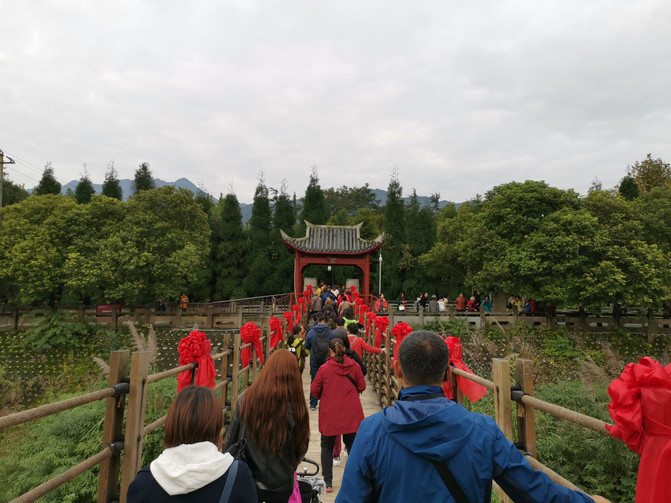
From Yuzui, you pass through the Anlan Cable Bridge and you reach the mountain. The mountain is not high, so you can stroll to Erwang Temple.
Erwang Temple was originally a Wangdi Temple commemorating the King of Shu, but later changed to worship Li Bing and his son. After the Song Dynasty (960 - 1279 AD), Li Bing and his son were successively made kings by the emperor, so later generations called it the "Erwang Temple". The main hall in the temple houses statues of Li Bing and his son, as well as famous quotes on water control, poet steles, etc. The buildings are distributed on the east bank of the Dujiangyan Canal Head. They are large in scale, rigorous in layout, and extremely quiet. It is a famous scenic spot that combines temples and gardens. The entire temple is a wooden structure. The temple relies entirely on the natural geographical environment and relies on the mountains. In terms of architectural style, it does not emphasize axial symmetry.


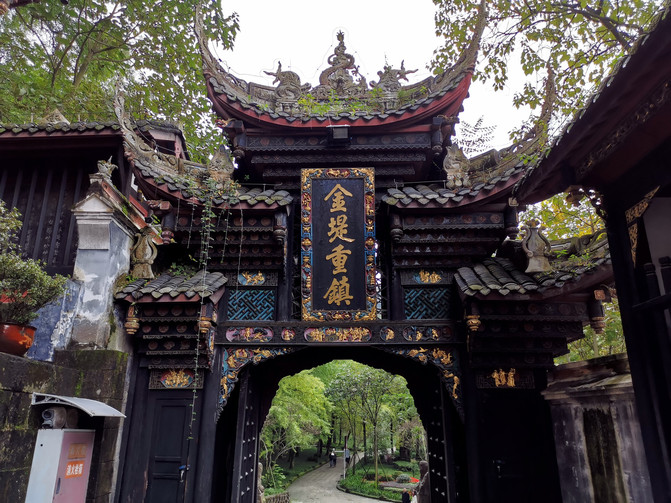









Deep scouring beaches and low weirs are called the "Three Character Classic of Water Control"

You can also eat vegetarian rice at Erwang Temple. I took a look and found that it is a dish added to the rice, which is different from Nanjing's Jiming Temple.


When you come out of Erwang Temple, you can walk along the mountain road to Yulei Pass. This is the highest point of the mountain. You can see the panoramic view of Dujiangyan without having to go to Yulei Pavilion and spend money on escalators.




The weather gradually became clear, with blue sky and green water. The commentators all said that it was difficult for Dujiangyan to have sunny skies. We were really lucky ~
Stroll all the way to the West Street of the ancient city of Guanxian County, which is said to be an entrance to Tibet on the Silk Road, just like the commercial street in every tourist city.


The only feature of West Street is that it is next to the mouth of the treasure bottle. You can see the other side of the mouth of the treasure bottle. It is very beautiful ~

After shopping for half a day, I finally wanted to eat ~ I walked around the ancient city for a long time before I found this private restaurant.


It is true that there are not many tables on the wall of the ancient city of Guanxian, but the tables are full.



While waiting for the dishes, I bought handmade tofu pudding, which tasted good.
We ordered a few signs, and to be honest, they were really delicious ~

Cowpea fish
The fish is fried and then poured with double peppers and cowpea juice. It is fragrant but not spicy. The rice is soaked in the soup, and the more delicious it becomes. PS: We eat it until there is not a drop left. I definitely recommend everyone to eat it with my conscience. I don't like fish, but I have also been conquered by cowpeas.

Double Pepper Rabbit
I don't know why Sichuan people like to eat rabbits so much. I tasted the rabbit meat a few bites, and it's quite tender.

twice-cooked pork
It is completely different from the twice-cooked pork eaten in Northeast China, the aroma of scallion oil and the taste of pork belly are completely integrated.

Pickled pepper and fresh bamboo shoots
Sichuan fresh bamboo shoots are delicious even if dipped in sauce, let alone cooked by chefs.

lebao beer
The beer is average, with a little water, but not as strong as Ha Beer at all.
After dinner, we walked around the ancient city again.



The eldest brother's figure is really everywhere, but very few people take photos with him.
I returned to Lidui Park Station and took the 16:24 intercity train back to Chengdu. I transferred directly to the subway and returned to the B & B. We were divided into three roads. I went back to the B & B to rest. Mom went to the supermarket to buy, and Dad and husband went to buy smoked rabbits, spicy rabbit heads and pot helmets.





This time I finally got up the courage to eat the rabbit head. It was okay, but the pot helmet was still as delicious as ever and numbing. I swallowed my saliva when I wrote about it.
Day 3 [October 28] Chengdu Giant Panda Breeding Base-Chunxi Road IFS-Qingyang Palace (Jiujiu Fresh Pot Vegetables)
It's 22℃ today. It's really great to see giant pandas in this weather ~
Four people took a taxi to the giant panda breeding base. The ticket price was 55 yuan, and the students were half price. I didn't see a newborn red panda last time I came here. This time, in order not to miss it, I really got up early. It was only 7:30 when I arrived at the base, and it was just dawn.


The giant panda base is really crowded with people whenever we go. There are too many foreigners. After queuing up to buy tickets, we immediately went to the scenic spot battery cart (10 yuan). After waiting for half an hour, we sat directly to the Moon Delivery Room.


I finally saw the 2-week-old red panda. Unfortunately, there were still many people. I could only queue up to visit and couldn't stay and take a closer look. The security guards would constantly urge me.


After watching Xiao Budian, I was not in a hurry. I slowly walked around the park and counted whichever one I saw. Anyway, they were all so cute ~






These two brothers have been fighting and become cute, and the onlookers exclaimed repeatedly ~
The advantage of going early is that you can see the little one and see the large, medium and small pandas having breakfast. I suggest everyone go early!








Lonely bamboo eater ~






Except for eating and sleeping ~ various postures ~







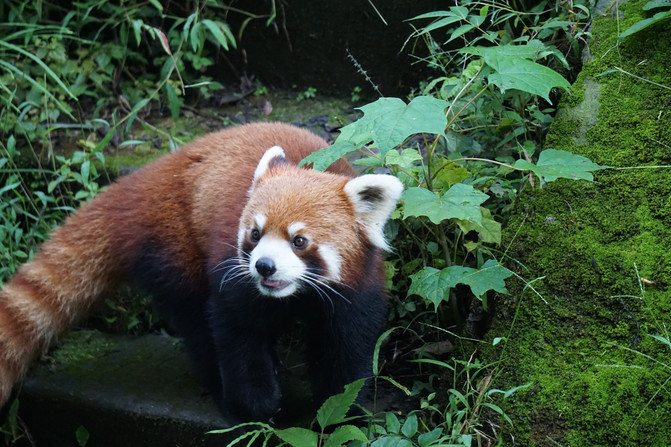






The red panda is also cute. When it runs, it surrounds the keeper and asks for pumpkins to eat ~



Red Panda Science Popularization Time ~

Walking around the Sun Delivery Room and seeing many staff on the set, we planned to gamble and wait a while to see if we could take out the red panda ~ The bet was really right ~



The staff carried out three month-old little hans, but they couldn't walk steadily ~





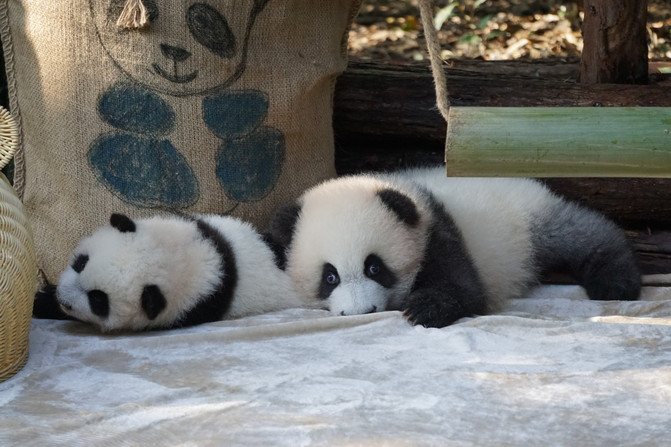



This is only the smallest one. It is basically lying on its stomach like a toy. Anyone can bully it ~





Three naughty people, keep crawling forward, naughty ~
The entire park is covered with bamboo and lush ~











Swan Lake ~
The tour was basically completed after 10 o'clock, and the giant pandas were basically fed and slept. We went to the Panda Post Office to buy postcards, took a taxi to the Panda Avenue subway entrance (13 yuan), took Line 3 to Chunxi Road (5 yuan), went to IFS to see the giant giant panda.
I had to go for lunch before going to IFS and found an old Sichuan restaurant run by local people. It was absolutely delicious ~
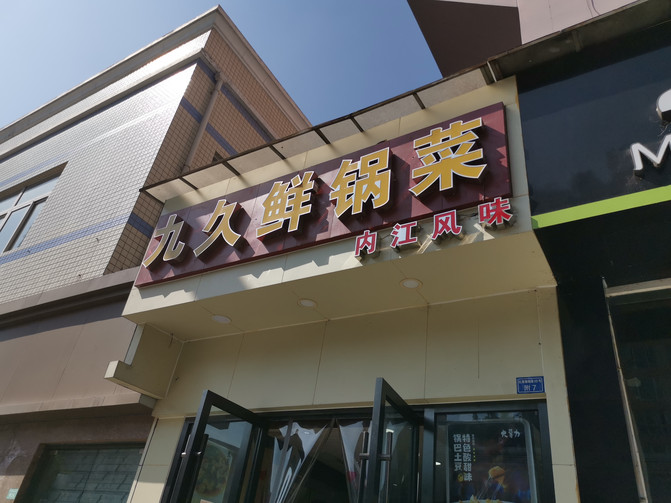



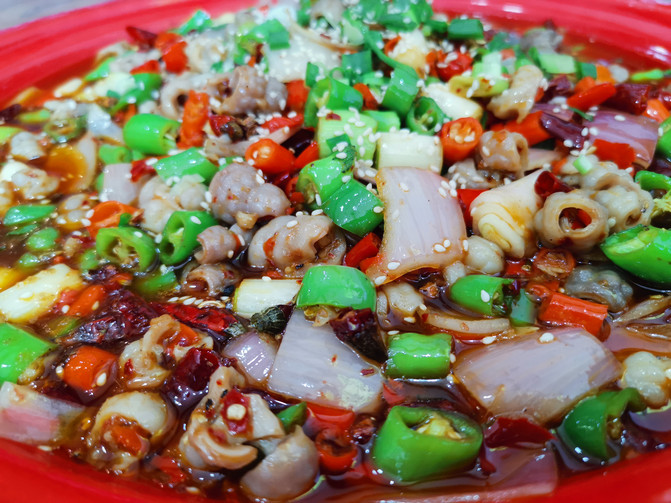
Raw fried crispy sausage
Sure enough, the word "crisp" is worthy of the chewy rabbit intestines.

Kung Pao Chicken
The overall taste of Kung Pao Chicken in Sichuan is slightly sour, and the chicken breast is soft, tender and smooth, which is more in line with the public's taste.

Special seasonal vegetable king
The vegetable platter promoted by the boss was indeed not deceived. The salty and fresh taste was very greasy and spicy.

Huodu Huanhua Silver Carp
Signature dish, silver carp is delicious and has a medium spicy taste. It is highly recommended by various food apps and is definitely worth a try.

Neijiangxiangwan
Northeast meatball tofu soup, there are slight differences in menu pictures.

pickled ginger
At first, I thought it was just radish and pickles, but I couldn't help but love it. This plate of crisp jerkels can definitely hold down a table of delicious food, and it doesn't have any ginger flavor, which is acceptable to most people.
After the ditch is full of flats, I will go to Chunxi Road IFS to see the giant giant pandas ~


Of course, when you get to IFS, you have to go to the Ninth Prince on the basement floor to eat skewers and dip them on dry dishes. It's great. Although I've just finished eating, I can't help but see skewers.
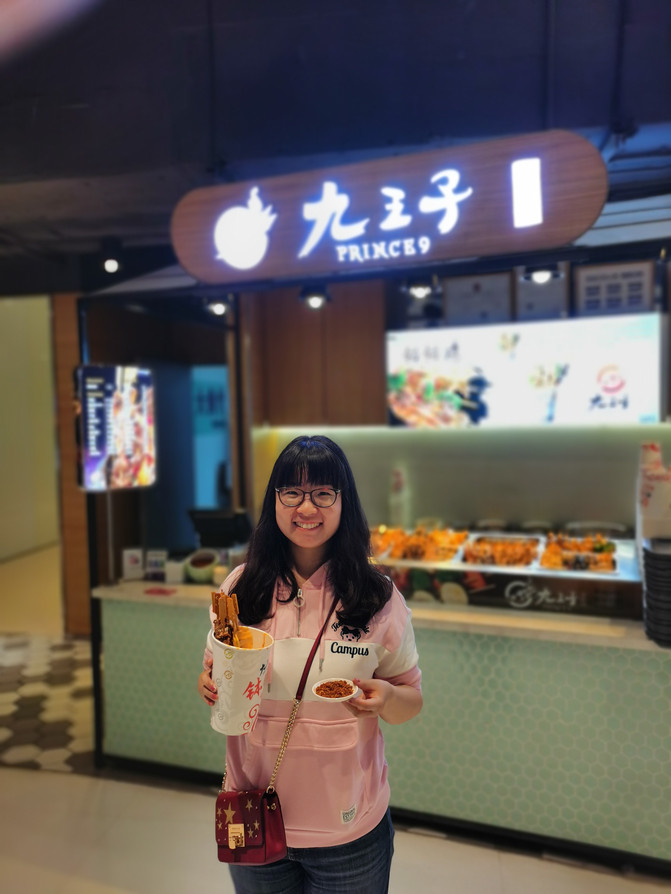

Take a break, take Metro Line 2 to the Provincial Hospital of the University of Traditional Chinese Medicine (4 yuan), and walk a little to Qingyang Palace (10 yuan)
Qingyang Palace-is currently the oldest and largest Taoist temple in Chengdu. Today's Qingyang Palace was built during the Kangxi period of the Qing Dynasty. There is a strong incense and a strong Taoist atmosphere here. Because it is not the regular route of tourist groups, it seems relatively quiet and a place for local elderly people to relax.


Legend has it that Qingyang Palace was built in the Zhou Dynasty and was initially named "Qingyang Si". It is said that it was directly connected to Lao Tzu, a Taoist master. When Lao Tzu rode a green ox out of Hangu Pass, he once said: A thousand years later, you will find me in Qingyang Si in Chengdu.


The main buildings of Qingyang Palace include the gate, Sanqing Hall, Tang King Hall, etc. The Hunyuan Hall in the palace is tall and majestic, and the Bagua Pavilion is the most completely preserved and luxurious building among them. It houses a statue of Lao Tzu riding a green ox.

A copper green sheep was presented by Prime Minister Zhang Penghe of the Qing Dynasty. It is said that touching it can cure all diseases ~
The Sanqing Hall is dedicated to Sanqing, the highest and most respected god of Taoism, namely Yuqing Yuanshi, Shangqing Lingbao, and Taiqing Daode, also known as Taishang Laojun. Most of the people I visit are Buddhist temples. This is the first time I visit Taoism, and I still feel very new.


Qingyang Palace can shake a lot to do divination, and a Taoist priest will cancel the lot (20 yuan). There is freshly squeezed pomegranate juice in the garden (10 yuan). It's very delicious ~

There is a tea garden in Qingyang Palace, where local elderly people are setting up Longmen. It is said that you can eat here for 2 dishes for 8 yuan. We just drank tea (8 yuan, including hot water and tea leaves) to experience the life of old Chengdu people.



Stay until 5 o'clock and the tea shop closes. Following the Cultural Park, we walked to Qintai Road, where we bought accompanying gifts for colleagues and friends.

Chengdu has a lot of beverage shops, which are cheap and delicious.



I rested at home at night. My husband took my parents to stroll around the wide and narrow alleys and bought me this meat pie (meat: rou suan). It was not bad and fragrant ~
The fourth day [October 29] Leshan, Chengdu-Kuanzhai Alley (Feng Sannang Cross-Foot Beef).
Today, I am going to Leshan to see the Giant Buddha. I have to go to Chengdu East Railway Station and take the intercity train to Leshan City. The 9:06 train will arrive in about 50 minutes. I am very nervous all the way, afraid that the weather is bad and I will not see the full picture of the Giant Buddha.


Who knew that when I arrived in Leshan, the weather would be sunny. After leaving the station, there would be a taxi waiting area on the right hand side. The Leshan driver was extremely talkative and introduced the local customs and customs, which gave me a very good first impression of Leshan. The streets were clean and the residents were enthusiastic. It is said that the food was still very delicious. A lot ~
We took a taxi (23 yuan) to the Baxian Cave Cruise Terminal. Because we were not sure about the queuing situation on the Leshan Plank Road today, we decided to take our parents on a cruise ship (70 yuan, no student ticket) to see the full picture of the Buddha, and then to see the situation and climb the plank road.




It was a bit of a lot of trouble to buy tickets. The ticket office was not at the dock. I still had to walk forward 300 meters to check in here. After boarding the boat, I basically set off the boat. The fog on the river was still a bit heavy, but fortunately the temperature was not low. Can I see the Buddha?



The boat slowly sailed towards the Buddha. The picture above shows part of the plank road we will walk later, cutting through the wall ~




The boat will stop in front of the Buddha for a while for everyone to take photos. There are also professional photographers on each boat. If you want to take photos and print them, you will add another 10 yuan if you want the electronic version. When the Buddha appears in front of you in the primary school watching "The Wind and Clouds Dominance of the World", the suffocating shock is really beyond words. You just look at the Buddha quietly, and your heart is extremely calm.
It takes only 30 minutes by boat. After landing, I stroll along the river to the main entrance of the Leshan Giant Buddha. Leshan City is so comfortable, as evidenced by the photos.



It takes 10 minutes to walk to the main entrance. What's ridiculous is that you can't buy tickets on site. Only tickets with special certificates can be bought. You have to buy tickets online and then exchange them on site. The ticket is 80 yuan, and the student ID card is half price.
If you check in to enter the scenic spot, you don't need to ask for an explanation at all, because there are groups all over the mountains and plains, and you can listen to a few words wherever you go. Follow the crowd to climb the mountain. Leshan is not high and will not be very tired.






In addition to the inscriptions, there are many stone Buddha statues on the mountain. Unfortunately, they were basically destroyed ~



You can see the top of the Buddha after walking to the end.
Leshan Giant Buddha, also known as Lingyun Giant Buddha, is located at the confluence of the Dadu River, Qingyi River and Minjiang River. The Buddha is a sitting statue of Maitreya Buddha, 71 meters high. It is the largest cliff stone statue in China. The Leshan Giant Buddha was excavated in the first year of Kaiyuan in the Tang Dynasty (713) and completed in the 19th year of Zhenyuan (803), taking about 90 years.
In ancient times, when the three rivers converged in Leshan, the water was quite fierce, and boats were often subverted here. Whenever there is a summer flood, the river hits the mountain walls, often causing the tragedy of shipwreck and death. Zen Master Haitong initiated the initiative in order to reduce the flow of water and save all living beings. He recruited manpower and material resources to build it.



There are 1051 snails on top of the Buddha. The Leshan Giant Buddha has a very clever drainage system. The ears and back of the head of the Leshan Giant Buddha have a cleverly designed and invisible drainage system, which plays an important role in protecting the Giant Buddha. Keep the Buddha statue from being eroded by rain.
Among the 18-layered snails on the head of the Buddha, there is a horizontal drainage ditch on the 4th, 9th and 18th floors, and drainage ditches are also provided for folds of collars and clothes.
There is a hole at each end of the back chest to drain water.


The Leshan Giant Buddha has its head aligned with the mountain, its feet treads on the river, and its hands rests on its knees. The Buddha has a well-proportioned figure and solemn aura. It is carved against the mountain and sits on the river. The Buddha is 71 meters high, the head height is 14.7 meters, the head width is 10 meters, the hair is 1021, the ears are 7 meters long, the nose is 5.6 meters long, the eyebrows are 5.6 meters long, the mouth and eyes are 3.3 meters long, the neck is 3 meters high, the shoulders are 24 meters wide, the fingers are 8.3 meters long, 28 meters from the knee to the instep, and the instep is 8.5 meters wide. More than a hundred people can sit around the feet.
In order to hold on to Buddha's feet, we have to go down from the plank road to the foot of the Buddha Buddha. When we see this sign, we should follow it.





The plank road is very narrow, so you have to be careful. My hands are shaking when taking pictures. I am very afraid. I must not play around. If you go to the end, you will be at the foot of the Buddha. You can take a closer look at the details of the Buddha.





You can donate incense money at the foot of the Buddha. What's funny here is that there will be a monk next to the merit box. At the monk meeting, you donate the money to the bowl in front of him. When you put the money, the monk will knock to pray for you, and will also depend on how much you donate. Consider whether to recommend you to provide lotus lanterns, you know ~
After the visit, what was painful was that I had to take the Jiuqu Plank Road and then climb up the mountain. When the newspaper came to Chengdu during the Spring Festival in 2018, the original 20-minute journey from bottom to top was blocked for more than 3 hours, so I gave up on coming to Leshan at that time. This time I only took 20 minutes to climb from bottom to top, but I was a little tired and sweaty.

Coming out is Lingyun Temple.


After visiting, you can follow the sign at the East Gate and go down the mountain. The scenery along the way is very good.








I left the gate at 13 o'clock, and on the left side was the taxi stop. It was time to visit the store that excited the whole family. I took a taxi (29 yuan) for about 20 minutes to go to niang's Stepping Beef for dinner. Many tourists recommend Fangfang Stepping Beef, but this one we found is an old restaurant that locals come to. It is super authentic and delicious, and it still has endless aftertaste ~



blood curd
It's the first time I've eaten such tender duck blood, paired with the unique Sichuan spicy pepper, tsk..

qiaojiao beef
The cross-legged beef itself is not spicy. A lot of pepper is added to the soup. The beef offal is eaten on a dry plate. It has chewy and flavor.

stir-fried beef tongue

Braised tofu with brain flowers
Sichuan's bean curd is famous. Only by eating it yourself can you taste its uniqueness and its spicy taste has no limit.

Steamed beef with rice flour

Brown sugar scones
This big cake surprised me the most. I didn't expect a professional restaurant who ate spicy food to be so good at making desserts. It was sweet but not greasy, and fragrant!


I went across the street and bought three fresh ice noodles. There were rice wine, small glutinous rice balls, ice noodles, and lemon. The taste was not bad and it was cold and cold ~


There was still a long way to go before the return trip, so we decided to visit Leshan City to see this small city.
Walking to Leshan Square, many elderly people were playing a card. They could be played by three or four people. It was very comfortable ~


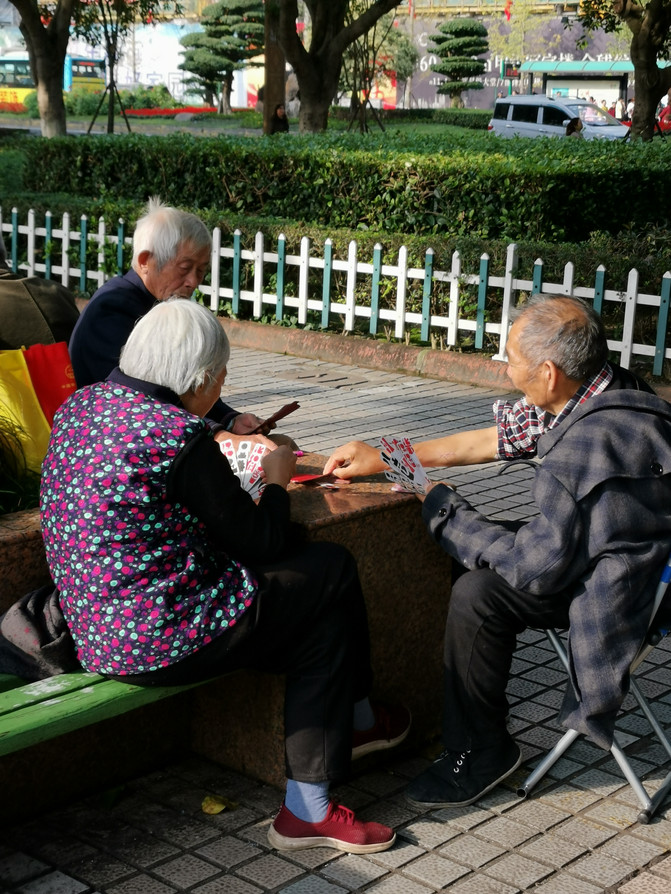

Only then did Baidu realize that this is called Leshan Bridge, also known as "Erqishi". It is only popular among the people. So far, there is no complete, standardized and rigorous set of rules in writing.
Although I couldn't understand it, I also seemed to be infected by the peaceful atmosphere of the local area. I also remembered the pride of taxi drivers praising his hometown. Leshan is really a livable city and suitable for elderly care!

Take the high-speed train back to Chengdu at 5 p.m. and visit the wide and narrow alleys.








Although I have visited the wide and narrow alleys countless times, I still can't help but visit those small shops. Panda things are just irresistible.

In Chengdu at the end of October, I wore sweaters and my husband wore half-sleeves ~


I had to ask Shu 'erlang to pick ears when I arrived in Chengdu. It was 60 yuan for more than 10 minutes. I didn't feel very comfortable. My husband said it was because the Shu' erlang I found was not skilled. He made it 10,000 times better than this last time.
Day 5 [October 30] Xi'an Sa Jinqiao-Hui Street
The high-speed train runs from Chengdu East to Xi'an Station at around 10:40. It takes almost three and a half hours to reach the destination. Get off the high-speed train and change directly to Metro Line 2 to Zhonglou Station. You can walk 500 meters to the B & B, which is not bad. After checking in, I went to sprinkle the golden bridge for food.




I bought a few steamed buns from this house, and they were delicious.


I came to Xi'an on a graduation trip in 2011, and I had such a good impression of Xi'an that after so many years, I still can't forget it and always recommend Xi'an to others. Back then, sour plum soup was sold all over the streets, but now it is pomegranate juice. Go to Jinqiao and Miaohou Street for a long walk and you will see the clearly marked price reading: 10 yuan for pomegranate juice with water, 15 yuan for pomegranate juice without water. It may also be a bumper harvest of pomegranate juice in October.


From Chengdu to Xi'an, local customs and customs have undergone tremendous changes. Because it is the off-season for tourism, there are really not many people. Xi'an is still the same as it was back then, and the snack street has not changed much.



Xi'an is basically full of snacks. As I walked and ate, I saw Li Weiyi's spicy soup (8 yuan). The taste was very different from the spicy soup in Zhengzhou, but it was also very delicious, very numb and thick.


The persimmon cake is still the same as when I came here in 2011. It has sesame stuffing inside, which is very fragrant.

We also bought 2 skewers of this red willow branch barbecue (10 yuan for each skewer). The northwest beef and mutton are really fresh.




After walking through Sanjinqiao, I found this dish with egg and steamed buns (7 yuan) that my best friend strongly recommended. The spicy pepper and peanuts inside are really fragrant, but the steamed buns are too hard and the vegetables inside are cold. The apricot skin tea (5 yuan) is also very special.
Walking back to the B & B from Sajinqiao was a little tiring, but I really couldn't get a taxi during the late rush hour. There is Hui Street near the B & B. I can go shopping and stuff something.


Xi'an at night can really make people feel trance.






I bought pomegranate on Miaohou Street. It was super big and super juicy (5 pieces for 10 yuan). It was fried with one knife. It was very sweet.

Day 6 [October 31] Xi'an Shaanxi History Museum (Biangbiang, Gongjia Courtyard)
I booked a ticket to Shaanxi Museum online in advance (you can make an appointment 7 days in advance, and if you go in peak season, you must make an appointment in advance), take the subway from Zhonglou Station to Xiaozhai Station (2 yuan), and walk 10 minutes from Xiaozhai to Shaanxi Expo. It's good for the off-season. You can't see the crowded queues, just go directly to the left side of the main entrance to exchange for a ticket. Be sure to note that the selfie stick cannot be carried and can be stored.






The exterior of the Shaanxi History Museum building highlights the style of the Tang Dynasty. Chang 'an has been the capital of emperors since ancient times. Historically, thirteen feudal dynasties including the Zhou, Qin, Han, Sui and Tang dynasties established their capitals here. It has rich cultural relics on the ground and underground, forming Shaanxi's unique historical and cultural features. When I came to Xi'an in 2011, it was the first time I came to this large-scale, luxurious, comprehensive museum with many cultural relics and other than the Forbidden City. At that time, I stayed in it for a day. I had the impression that there were no treasure museum. All cultural relics were displayed together, and there were so many cultural relics that I was afraid of encountering anything when I turned around. The guide was also very good and gave the explanation very detailed. I was a little disappointed this time. The treasures paid for the visit separately, the guides were very amateur, the number of cultural relics dropped sharply, and the supporting cultural and creative supplies were really very backward.


As soon as I entered the door, there were guides on the right hand side. I could work with other tourists. 100 yuan would work for 10 people. However, when we arrived, the guides were sent out, and many people were waiting foolishly. It was finally difficult to wait until the next round of lectures. When we went to work, we assigned a guide who gave a poor explanation. It only took us 40 minutes to talk about the ordinary museum. I bought a ticket for the Treasure Museum (30 yuan) and went in and visited it.
In October 1970, during infrastructure construction, two pottery urns and a lifting beam jar were unearthed in Hejia Village in the southern suburbs of Xi'an and Xinghua Square in Chang' an City in the Tang Dynasty. More than 1000 pieces of gold and silver ware, jade ware, precious medicines, Chinese and foreign coins, and bronzes buried deep underground for thousands of years reveal their true appearance.


Jade belt

The treasure of the town hall--the agate cup inlaid with the head of a gold-inlaid animal, jade from the Tang Dynasty
The cup is 6.5 cm high, 15.6 cm long, and 5.9 cm in diameter. The cup body is horn-shaped animal head shape. The horns of the animal are cup handles. The mouth is inlaid with a gold cap. The eyes, ears and nose are all engraved with fine precision.

Gilded flying lion engraved silver box

Grape flower and bird pattern silver sachet-used to set off solid spices
The outer diameter of the sachet is 4.6 cm, the diameter of the golden spoon is 2.8 cm, and the chain length is 7.5 cm. The outer wall of the sachet is made of silver and has a spherical shape. The whole is hollow out. It is evenly divided into two hemispheres with the middle horizontal line as the boundary. Between the upper and lower spheres, one side is hooked with a hook chain and the other is nested with a living shaft. Two layers of silver concentric circular machine rings connected with two shafts are arranged in the lower sphere.

Red gold walking dragon-a ritual tool used in sacrifice

Gilded gold dancing horse cup tattooed silver pot
Horses in the Tang Dynasty were not only widely used in war, transportation, transportation, and post transmission, but were also widely used in social and recreational activities of court aristocrats. Among them, the horse dancing during the Xuanzong period of the Tang Dynasty was the most special. According to records in the "Emperor Ming Za Lu", during the reign of Emperor Xuanzong of the Tang Dynasty, hundreds of dancing horses were raised in the palace. Xuanzong often watched and trained himself. Every time on August 5th, Xuanzong's birthday, a grand celebration is held downstairs in the Xingqing Palace's diligent government office, and horse dances are used to add to the fun. At this time, the dancing horses were dressed in gold and silver, dancing in the music of "Pour the Cup Music". After the song was over, the horse dance held a glass full of wine on the ground to the emperor to wish his birthday. literati of the Tang Dynasty once wrote many poems about horse dancing,"bend your knees and go to the festival with a cup, dedicate your life to life without limit", and "there is also a final banquet song with a cup, hanging your head and tail as drunk as mud" are all true descriptions of it. The shape of the dancing horse cup on the silver pot is a true reproduction of the birthday celebration scene at that time.

Tang Kaiyuan Tongbao
The collection in the Treasure Museum is quite good, but I got a tour guide who gave the lecture very good. After walking around, I found the beautiful and shocking feeling of those years. After 11 o'clock, my husband took my parents to the Big Wild Goose Pagoda, and I continued to visit the museum. There is a restaurant on the first floor of the museum, which can serve lunch. It is impossible to taste as delicious as it is, but it is still okay to fill your stomach (45 yuan).


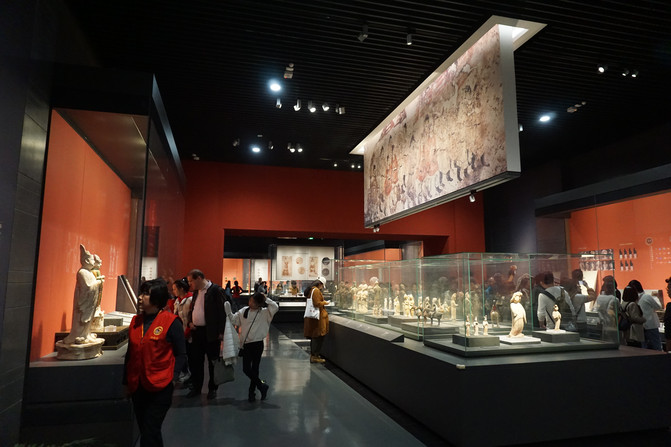
The Shaanxi History Museum is divided into seven units, and each unit has fine works. I visited it in this order.
Unit 1 Cradle of Civilization
--Prehistoric period (about 1.63 million years ago to the 21st century BC)
Shaanxi, located in the middle reaches of the Yellow River, is the birthplace of the Chinese nation and one of the cradles of ancient civilization. The ancient human remains such as the Lantian people and Dali people discovered in Shaanxi, as well as early cultural sites such as Banpo in Xi'an, Jiangzhai in Lintong, Yangguanzhai in Gaoling, and Shenmu Shimao, reflect the formation and evolution of the ancient ancestors here and the survival and development of the situation, reproducing the basic characteristics of Shaanxi's prehistoric civilization and the vibrant childhood of the Chinese nation.

Neolithic animal-faced pot (Yangshao Culture)
Unit 2 He Zongzhou
--Zhou (about 21st century BC to 771 BC)
Xian Zhou (during the Xia and Shang Dynasties, 21st century BC to 11th century BC)
Western Zhou Dynasty (11th century BC-771 BC)
The Western Zhou Dynasty was an important stage of development in the early country of China. Its political system, economic form, especially its ethical spirit, had a profound impact on later generations. Therefore, Confucius sincerely praised and praised: "It is so gloomy that I follow the Zhou Dynasty." Shaanxi was the capital and political center of the Western Zhou Dynasty. Rich relics and relics represent the resplendent Western Zhou civilization.

Shang--Horse Head Knife

Western Zhou Dynasty--Fu Ding, Fu Gui

Western Zhou Dynasty-Five Sacrifices? (fu) clock
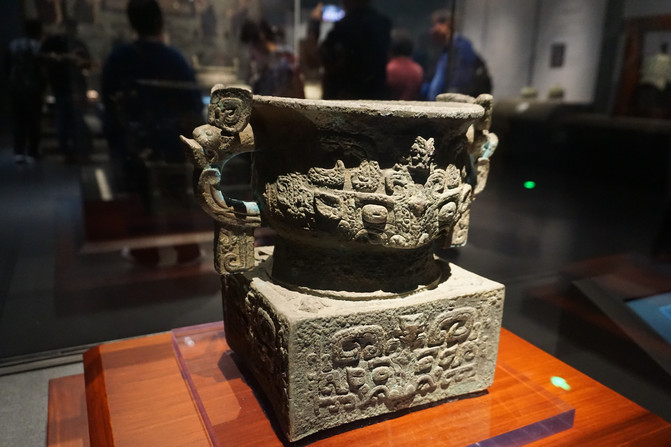
Western Zhou Dynasty-Li Gui

GE



Western Zhou Dynasty--Niu Zun



Western Zhou Dynasty--Liang Qihu

Western Zhou Dynasty--Chimes




Western Zhou Dynasty--Tiger Ying


Western Zhou Dynasty--Binglu




Western Zhou Dynasty-Riji Gong
I think the bronzes of the Western Zhou Dynasty are really exquisite. Thanks to current cameras, I can see the details so carefully.
Unit 3 Eastern Empire
--Qin (770 BC-207 BC)
Qin (770 BC-221 BC)
Qin Dynasty (221 BC-207 BC)
The Qin people are a branch of the Chinese ethnic group and once lived in the Tianshui area of present-day Gansu Province. After King Ping of Zhou moved eastward, the Qin people developed rapidly based on Shaanxi. In 221 BC, Qin Shihuang unified China and established the first unified centralized state in history. Its political, economic, and military systems set an example for future generations. The cultural relics of the Qin Dynasty, represented by the Terracotta Warriors and Horses, with their majestic momentum and distinctive military characteristics, show the Qin people's strong pioneering consciousness and enterprising spirit.

Warring States-Bronze Dragon (scholars believe this is the base of a giant instrument stand)

Warring States--Gilinhu Town

Warring States-Cuojin Du Hufu (Du Hufu consists of two halves, the shape and inscription of the two halves are the same. Together, they become a token of troop mobilization and are the earliest troop mobilization certificate in my country)


Qin--Shigu (a four-character poem engraved above)

Qin--Stone Armor



Qin Dynasty-Painted kneeling and shooting figurines

Unit 4 Xiongnu
--Han Dynasty (202 BC-220 AD)
The Western Han Dynasty, which established the capital of Chang 'an, created the first prosperous age in ancient Chinese society. With the opening of the Silk Road, Chang 'an City, as the starting point of the Silk Road, has gradually become the center of East Asian civilization and a famous international metropolis. Therefore, for the first time, China has moved from Chang' an and Shaanxi to the world as a powerful country. Chang 'an, the capital of the Han Dynasty, the tombs of the Han Dynasty, and a large number of cultural relics of the Han Dynasty reproduce the developed and prosperous social economy, rich and colorful social life, vigorous and profound culture and art, and the vigorous spirit of the times in many aspects.

Han--Painted Goose and Fish Lantern

gold cakes

Han pottery figures

Four God Tile Dang (i.e. Green Dragon, White Tiger, Rosefinch, Xuanwu)

Changle Weiyang Wadang
Unit 5: Conflict fusion-Wei, Jin, Southern and Southern Dynasties (220 AD to 581 AD) During the Wei, Jin, Southern and Southern Dynasties, wars were frequent and regimes changed. Various ethnic minorities in the north compete, migrate, conflict, and integrate in Shaanxi. Agricultural civilization and grassland civilization develop and progress together through exchanges and complementarity. The Silk Road is still prosperous. The eastward spread of Buddhism has promoted the development and prosperity of culture and art.







Cultural relics from the Wei, Jin, Southern and Southern Dynasties are all naughty
Unit 6 Weather of the Tang Dynasty
--Sui and Tang Dynasties (581 AD-907 AD)
The Sui and Tang Dynasties were the most glorious period in ancient China. Chang 'an (now Xi'an City) became the largest and most prosperous city in the world. Through the prosperous Silk Road, China has extensive exchanges with the world, and the politics, economy and culture of the Sui and Tang Dynasties have developed in an all-round way. Shaanxi cultural relics during this period reflect the glorious achievements and style of the times of the eclectic, innovative and development of the Tang Dynasty's prosperous culture.




Five Generations-Celadon lifting beams and pouring back into the pot
This unique shape and cleverly conceived inverted pot has a round body, and the lid, beam and body are connected into one body. The symbolic lid of the pot is shaped like a persimmon stalk, and the lifting beam is a lying phoenix with round eyes and short mouth. The spout of the pot is a lioness lying on her side with her mouth open. A lion cub is sucking milk under her abdomen. It is very vivid, lively and lovely. The body of the pot is decorated with convex carved branches of peony flowers, and the bottom is decorated with lotus petals. The decoration is simple and bright. Because the phoenix, lion and peony are the kings of birds, the king of beasts and the king of flowers respectively, this pot is also called the "Three Kings Pot".
There is a five-petal plum blossom hole in the center of the bottom of the pot. When filling water, the pot is inverted. When water flows out of the lioness's mouth, it is full. Because there are leaking columns in the pot separated from the water, although there are holes in the bottom, it will not leak. This makes use of the physical principle of "connecting the liquid level in the container with the same height" and reflects the wisdom and ingenuity of craftsmen and artists.



Golden bowl with mandarin duck and lotus petals pattern

Capricorn patterned gold cup (Capricorn is an animal with a dragon's head and fish body in Indian mythology. With the introduction of Buddhism to China, objects in the Tang Dynasty have increasingly reflected the integration of Chinese and Western cultures)

Gilded gold shop head (unearthed from the Daming Palace site)
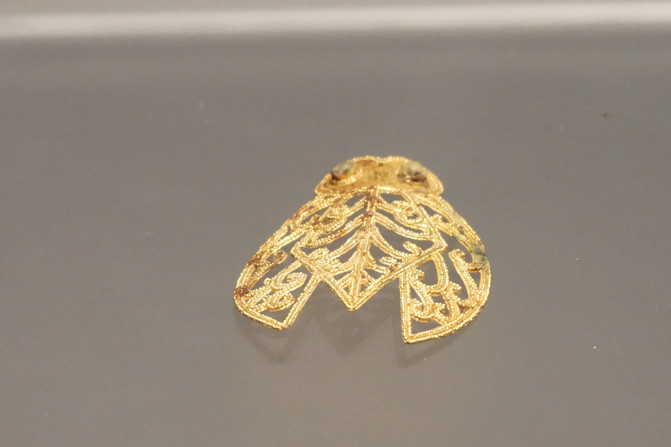
hollow golden cicada


When I was a child, I didn't like to read words and paintings, and I couldn't understand the techniques. Now when I grow up, I feel that the calligraphy and paintings are really exquisite. On the contrary, they are the gold objects I loved most when I was a child. Now I really don't get interested in them.
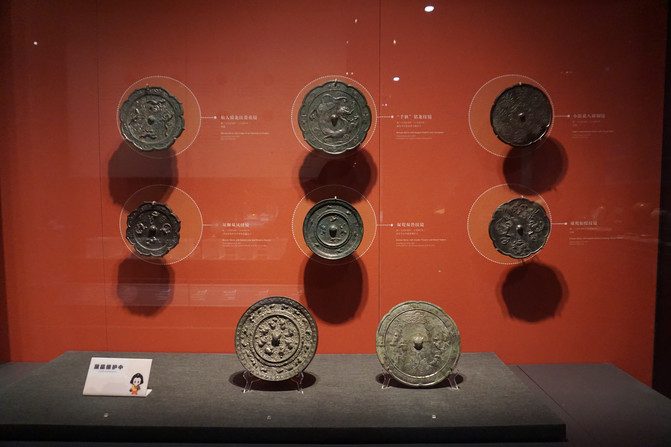



Beast head grape mirror (popular during the Tang Gaozong and Wu Zetian periods)

Three-color three-flower horse


Three-color elephant first cup

Three-color watermelon

Gold-plated octagonal silver cup with vines and flowers and birds pattern

Gold-plated high-footed silver cup with vines and birds pattern





Three-color figurines

Painted polo figurines

Painted twelve zodiac figures

Gilded copper animal head hinge jade ring

Exoter-shaped white marble town

Gilded and engraved Tongyang Town


Three-color camel figurines carrying music





Painted Tomb Beast

Unit 7: Long cultural context
--Shaanxi after the Tang Dynasty (907 AD-1911 AD)
After the Tang Dynasty, as China's political center moved eastward, Shaanxi bid farewell to its long-term history of owning the imperial capital. However, as the political, economic and cultural center of the northwest region, the cultural creation and inheritance on this land are still unique and charming.

Song--Yangko Dance Portrait Brick

Qing--Ivory radish
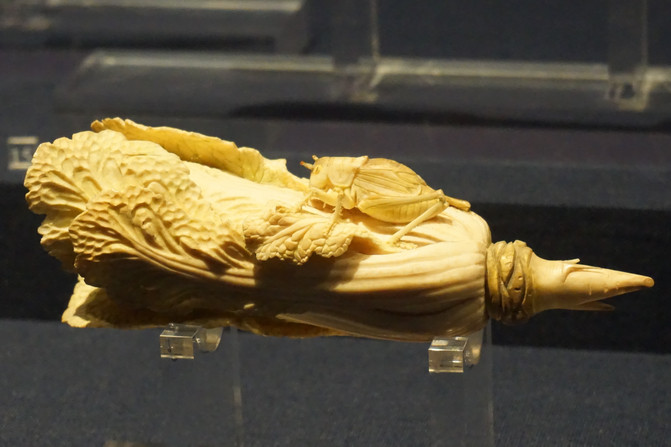
Qing--ivory cabbage

Qing--ivory paper cutter

Northern Song Dynasty--Luotuozhan



The pottery figurines of the Song Dynasty should have been traveling in honor of honor. The pottery figurines should have objects in their hands, but the objects should have been carved from wood and so they were rotten.

Song--Black Glaze Oil Drop Bowl
The black glaze bowl has a big mouth and small feet, has a gray body, and is covered with black glaze throughout the body. The surface of the oil layer is covered with small dots of varying sizes, called metallic luster. These dots are like oil droplets floating on the water, so they are called "oil droplet glaze." Oil drop glaze is a special type of black glaze and belongs to crystal glaze.




After visiting the main exhibition hall, I accidentally discovered the digital exhibition hall on the first floor, which displayed the Tang Dynasty murals. I previously checked the information on the Tang Dynasty murals and the ticket is 270 yuan. And it's very dark inside. For various considerations, I'd better look at the murals in the digital exhibition hall.




What surprised me was that when all major museums across the country had their own cultural creations, the Shaanxi History Museum did not have them. It was still Xi'an cultural creations designed by a third party, which was somewhat disappointing.
I didn't sit down and rest until after 3 o'clock in the afternoon. I couldn't feel my legs. I made an appointment with my family to meet at the Bell Tower subway exit for dinner. Lao Wan Noodles in Gongjia Courtyard on Dongmutou Street ordered biangbiang Noodles. An extra large bowl (15 yuan) is so fragrant!





Look at this surface, it is long and wide, but I don't want this bowl to be big and round. The large wide noodles are served with three kinds of stews and sprinkled with oil and chili to make it delicious biangbiang noodles ~
After eating, I took a taxi back to the hotel!
Day 7 [November 1] Xi'an Terracotta Warriors and Horses-Gaojia Courtyard (Mother's Cuisine in Southern Shaanxi)
Today, I slept until I woke up naturally. I went out to eat mutton and steamed buns from Yizhen Building at around 9 o'clock.


Tourists are all arranged to have meals on the first floor, and local Muslims can treat the second floor ~
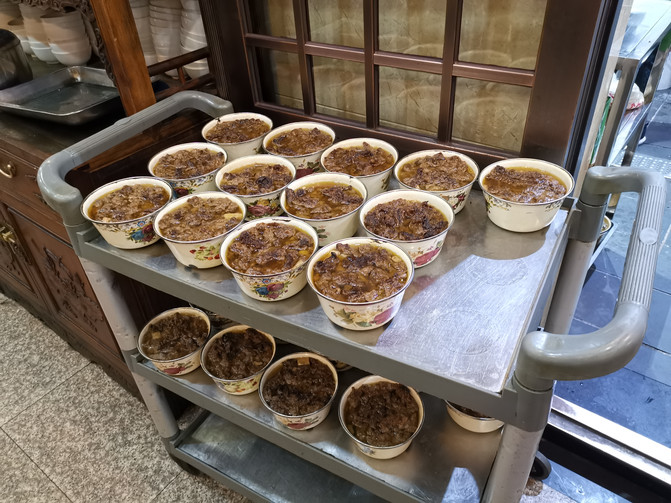
Dozens of bowls of meat are made every morning. Locals with good conditions will buy them and stew them themselves, while those with poor conditions will only buy broth and cook them.

The waiters are all Hui people. There are 2 steamed buns in one bowl. They need to break them up bit by bit and send them to cook. It takes about 20 minutes to cook them before they come out of the pot. We also bought some small dishes. This meal is really full, the mutton is so delicious!
The four of us happened to take a taxi to the Terracotta Warriors (120 yuan). It was about an hour away. The driver had been promoting explanations, tickets, romance, etc. Seeing that we were not interested, he drove quickly and the reviews were bad.


Qin Shihuang Terracotta Warriors (admission is 120 yuan, half price for students, and student ID checks are very strict) is a category of ancient tomb sculptures. In ancient times, human martyrdom was practiced. Slaves were accessories of the slave owners during their lifetime. After the slave owners died, slaves were to be buried with the slave owners as sacrificial objects. Terracotta warriors are made into sacrificial objects in the shape of horses and horses (chariots, horses, soldiers). It is known as "one of the great discoveries in the archaeological history of the 20th century."
Qin Shihuang began to build the cemetery when he ascended the throne at the age of 13. It used nearly 720,000 manpower and took 38 years to build the cemetery. The project was huge. The construction of the cemetery was not completed until the death of Qin Shi Huang. It was continued by Hu Hai, the Second King of Qin Dynasty, for more than a year before it was completed. It is rumored that Qin Shihuang spent countless manpower, material resources and financial resources to build an underground palace for himself, and the Terracotta Warriors were the guardians of the underground palace.
In order to see this underground kingdom, we hired a tour guide (122 yuan). After checking in, it took 10 minutes to walk to the ruins. Fortunately, the scenery was good.

It's the lion harvest season in Lintong. In "Chang 'an Twelve Hours", this is the fire crystal persimmon that Zhang Xiaojing ate after he was released from prison. At that time, he was watching the TV series, Xiao Jing used a bamboo straw to stick it on the persimmon and sucked it. I was very curious and thought it was a ripe persimmon. After asking the tour guide, I found out that it was this persimmon. Because the persimmon is very soft and has no seeds inside, you can suck and eat the pulp and melt it in your mouth.

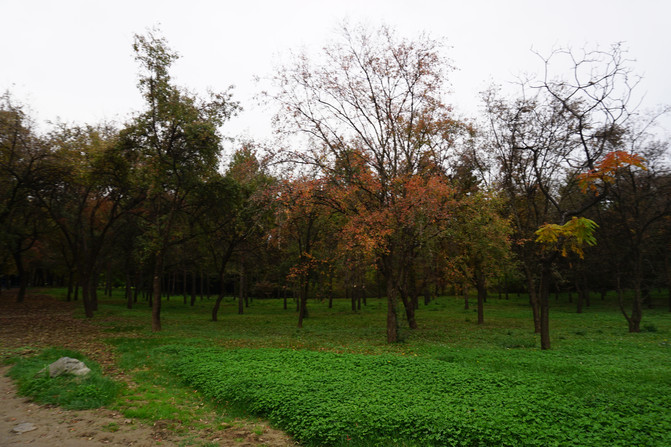


Fortunately, we also met Bingdan, the terracotta warriors commentator who is now shaking the sound of Rite Fire, and he also happened to lead the group.
The order of visiting was Pit 1-Pit 3-Pit 2, with a shopping store interspersed in the middle, all selling pottery figurines made of local soil. I wondered who would buy a burial object of terracotta warriors and put them at home. As a memorial.
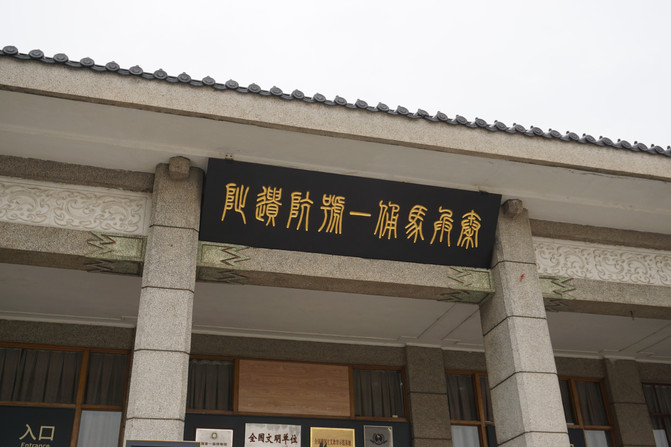

In March 1974, farmers in Xiyang Village, Lintong District, Shaanxi Province accidentally discovered some fragments of pottery terracotta warriors while digging a well. After more than a year of exploration and trial excavation, archaeologists confirmed that it was a large-scale pit. This is the world-famous No. 1 Terracotta Warriors Pit.



Pit No. 1 is a more shocking exhibition hall that has been pieced together so far. You can see huge terracotta soldiers standing in the pit. They are in various shapes. It is said that there are more than 30 shapes in terms of beards alone. Upon closer inspection, every soldier is lifelike, from armor to expressions, from weapons to the patterns on his palms, everything is amazing.




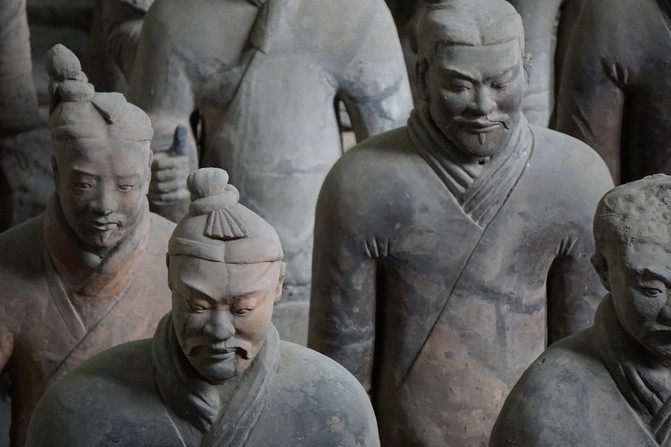










During the working day of Pit No. 1, staff are on site every morning to repair the terracotta warriors. It is said that it will take several years to repair one.

The tour guide said that the higher the front edge of the shoes, the higher the official position.
In April and May 1976, the No. 2 and No. 3 Terracotta Warriors pits were discovered on both sides of the No. 1 Pit. Each pit had different sizes, shapes and unearthed utensils. Some scholars believe that Pit No. 3 was the headquarters for commanding the No. 1 and No. 2 Terracotta Warriors Pit, and was called the "Military Curtain" in ancient times. Although the shock is not as shocking as the No. 1 pit, because the team and role of each pit are different, it is also worth seeing.









The terracotta warriors unearthed here can be divided into general terracotta figures, warrior terracotta figures, chariot terracotta figures, etc. According to their different costumes, expressions, and hairstyles. Each terracotta figure has different face shapes, hairstyles, posture, and expression. The pottery figurines and pottery horses were originally painted, but due to subsequent fire and immersion, most of them peeled off and discolored.


The tour guide took us through three pits. When we saw that there was no profit, we left and asked her why the bronze chariots and horses exhibition hall didn't explain it. She actually lied to us and said that all the cultural relics had been lent out for exhibition. I couldn't bother with her.
In December 1980, archaeologists unearthed two large painted copper chariots and horses underground about 20 meters west of the seal of the Mausoleum of the Emperor Qin Shi Huang and about 7 meters deep from the surface. These were discovered earlier in the archaeological history of my country. Large, relatively well-preserved bronze chariots and horses. There are four horses driving in front of each ride, and there is a royal official figure on each ride. The copper chariots and horses are lifelike in shape and richly decorated. They use a large amount of gold and silver as ornaments and components. They are very exquisitely made and are known as the "crown of bronze".
The two cars were broken into more than 3000 pieces when they were unearthed. After nearly 8 years of careful restoration, they were put on display in 1989. The two bronze chariots and horses, one is a "vertical chariot" and the other is an "Ancha". They are both ancient single-shaft two-wheeled carriages and are made at a ratio of 1/2 of the Qin Dynasty's real chariots and horses.
The copper chariot and carriage are entirely cast in bronze, and the weight of gold and silver ornaments exceeds 14 kilograms. They are assembled from more than 3500 parts by various processes such as casting, inlay, welding, button connection, and living hinge connection.


There are four copper horses in front of the No. 1 car. The plane of the car is a horizontal rectangle and the two front corners are arc-shaped. The car is 74 centimeters wide and 48.5 centimeters deep. The carriage (wooden boards on which people can lean on on both sides of the carriage) is low and open on all sides. A high-pole copper umbrella is erected in the carriage. Under the umbrella is a royal official figure standing. The carriage is equipped with copper crossbows, copper shields, copper arrowheads and other weapons. The No. 1 carriage was a vertical carriage among Qin Shihuang's carriages, also known as the high carriage. Although the No. 1 car has an umbrella, it is open on all sides and equipped with weapons. In essence, it should be a personnel vehicle. In "Absolute Judgment", Cai Yong described Qin Shihuang's carriage and carriage to ride Lu Bo's ceremonial ceremony: "There were also Rong soldiers who set up chariots to conquer," which explained the role of upright chariots in opening roads, guarding and conquering in the emperor's motorcade.





The connection processes of Qin copper chariots and horses are diverse. The commonly used ones include loose-leaf connection, plug-and-button connection, plug-and-button connection, and button connection. The loose-leaf connection is mainly used to connect the door leaf and the door frame, the sash and the window frame on the No. 2 car. The structure of the loose-leaf is almost identical to that of the modern hinges.



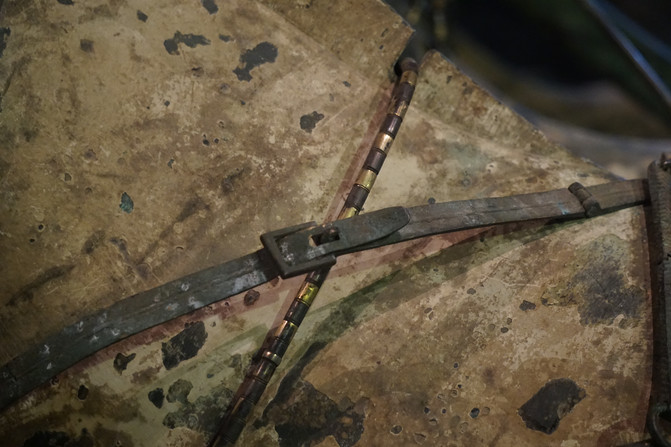
The connection method of buckles and pins is widely used in the saddles of copper chariots and horses, such as ropes, bridle ropes, reins, etc., all of which use sections of copper or gold and silver components, and the connection method of buckles and pins is used to form the chain. This connection method is to machine one end of two small members into a concave and convex shape respectively, and then insert the convex end of one small member into the concave end of the other small member to make the two small members completely fit, and then add a pin at the joint to make them completely connected together, but there is a certain space for movement.
The end of the bridle rope of No. 2 carriage has the four words "The first to install a carriage" in the Zhu Shu, which can be identified as an ancient carriage. The No. 2 car has a total length of 317 centimeters, a total height of 106 centimeters, and a total weight of 1241 kilograms. It has a single shaft and two yokes. The four horses are divided into two uniforms and two carriages. The horse is 90.2 cm-93.6 cm high and 110 cm-114 cm long. It is white all over, and only pink is applied to the nostrils, mouth, etc. The carriage is divided into two rooms, front and rear. The front room is very small and only allows the royal hand to sit. In the bronze carriage, the terracotta of imperial officials wearing double rolled tail crowns, long jackets, and short swords at their waists sat in the front room of the carriage, holding the bridle rope in their hands. The back room is the main carriage for the owner to ride on, with a width of 78 centimeters and a depth of 88 centimeters. The main carriage is shielded around it, with a door left behind, and the door is equipped with door panels that can be opened and closed; windows are opened on the front and left and right sides. The front window is equipped with diamond-shaped hollow sashes that can be lifted upward, and the left and right windows are installed in a sandwich manner. Pushable diamond-shaped hollow window panels. The top of the carriage room is covered with an oval vaulted canopy with a length of 178 centimeters and a width of 129.5 centimeters. There is a copper plate painted with geometric patterns on the bottom of the carriage, symbolizing the soft mat. The inside and outside of the carriage are decorated with exquisite decorations. The shield of the carriage room and the cover are mainly composed of Kui dragons and phoenixes. The periphery of the carriage and the inside and outside of the front room are decorated with cloud patterns, geometric patterns and other patterns.






After visiting the two copper carriages, we will continue to visit the Qin terracotta warriors up close.



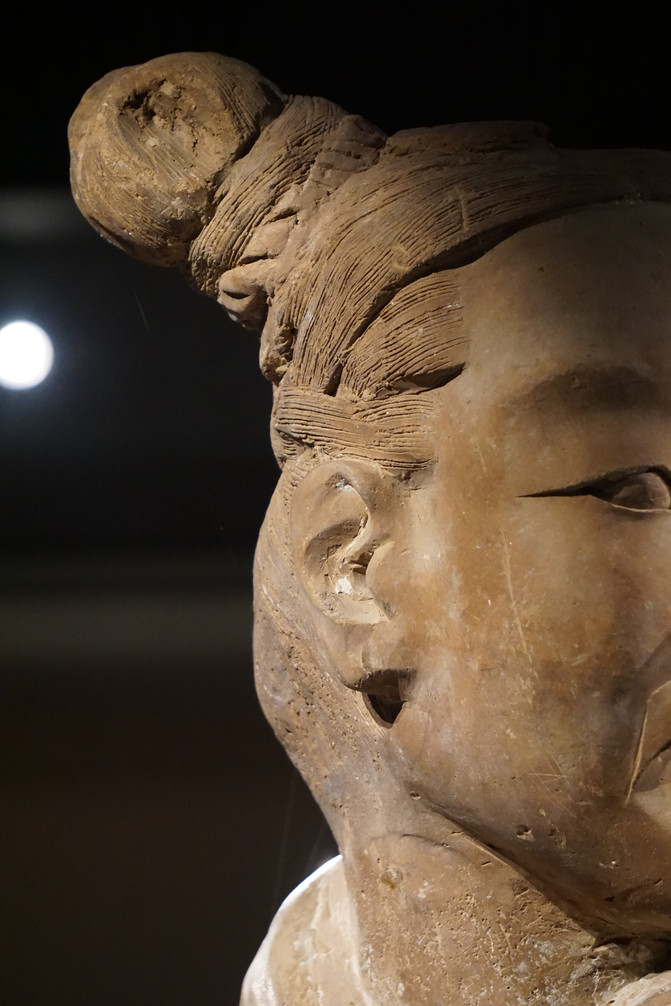
In that era, the workmanship was really very fine, and the hair was really clear.




The soles are still non-slip ~





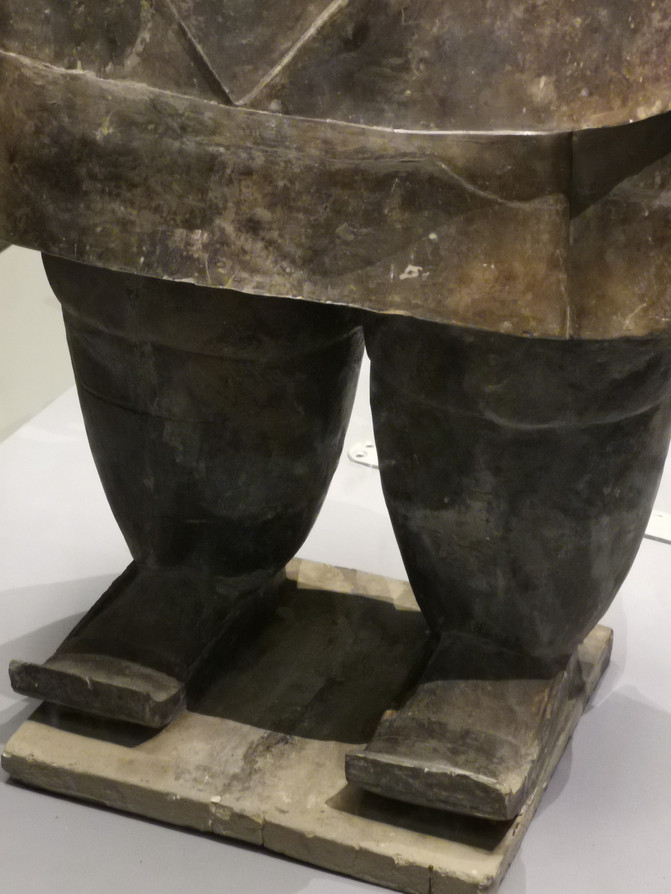
The terracotta soldier of the general, viewed from the side, has a beer belly, and the front edge of his shoes is indeed very sharp.

Young terracotta soldiers.




This cultural and creative store is quite interesting, and the refrigerator stickers are not expensive. After leaving the Terracotta Warriors at around 3 p.m., you can visit the Mausoleum of the First Emperor of Qin. Although there is no excavation, there is a free shuttle bus and a guide for free explanation. I want to join in the fun.



Finding a shuttle bus is also difficult and there are no signs.

I inquired about it all the way and said that there was a statue of Qin Shihuang. Sure enough ~
Basically, we can leave as soon as we get on the bus and arrive in 5 minutes. Unfortunately, it was off-season for us to go there and there were no guides. I couldn't understand it by myself.




We couldn't tell the difference between east and west. We could see a mountain top from afar, and then we turned around the periphery of the enclosure. The signs were unclear, which caused us to walk a lot of wrong roads.


After coming out, there is a bus to Xi'an Railway Station at the door. It is also 10 yuan per person. It is kind enough to go to the city in about an hour and hurry to find food.


Homemade old yogurt + osmanthus honey
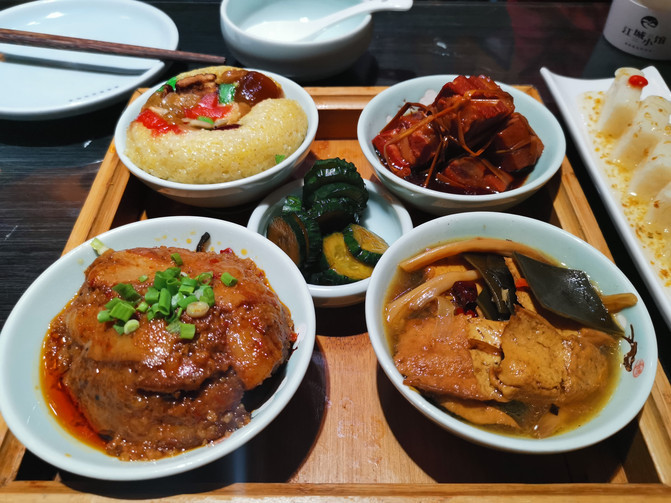
Hansipin
Traditional Shaanxi cuisine still has a more traditional northern flavor. One dish shows the boldness and unrestraint of Shaanxi.

Stir-fried bacon with mountain bamboo shoots in Qinling Mountains
I definitely ordered this because I didn't eat enough bamboo shoots in Chengdu, hahaha

stir-fried beef with sour radish
This sour radish immediately reflects the characteristics of Shaanxi cuisine. It has color, aroma and shape. It is delicious and cannot stop. The small sour radish has a unique taste.

Ziyang steamed basin
This dish is not recommended. Stewed radish in chicken soup with four egg dumplings swimming on top. If I came, five people would have to fight.

Hanzhong osmanthus jelly cake
A very good dessert, like a big man sitting in front of him with an embroidered sachet tied around his waist. It's amazing.

Southern Shaanxi big flower roll

After dinner, stroll around the Bell Tower and Drum Tower casually.

Gulou

bell tower


This is the road that Lao Ding and I had to take every time we went to Hui Street in 2011. It has been 8 years in a flash, and I am really sad.




mutton ti

Huojing Persimmons (We bought 10 for 8 yuan, they are really delicious)
On Hui Street, where people come and go, there is also a Gaojia compound worth visiting. The main building of the Gaojia Courtyard was built during the Chongzhen period of the Ming Dynasty and has a history of more than 400 years. It is currently the best preserved ancient building in the Ming and Qing Dynasties in Xi'an City.
We bought a set ticket of shadow puppets + Qin Opera +50 yuan, but there were no student tickets.






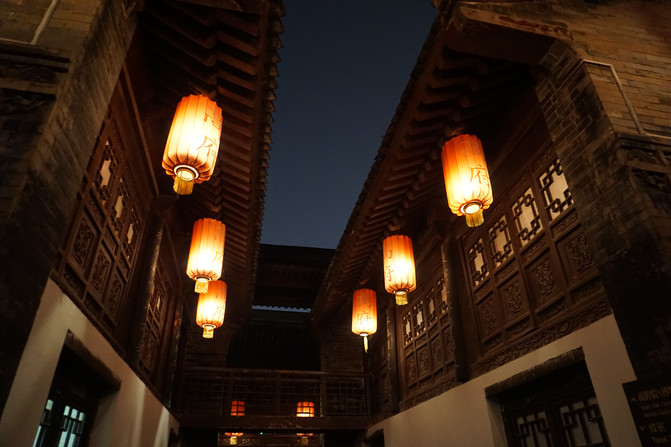




We watched the shadow puppet play "The Trailer"(10 minutes) in Dafengtang. The Trailer can still smoke and spit out smoke


After watching the shadow puppets, you can wait to watch Huayin Lao Opera (10 minutes). To be honest, I really can't understand a word. Moreover, the old artists 'movements are extremely exaggerated, just to understand different cultures.






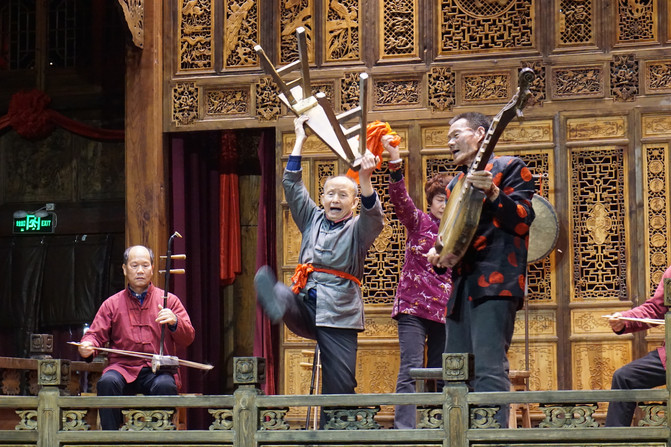

Day 8 [November 2] Xi'an Little Wild Goose Pagoda-Xi'an Museum-Yongning Gate City Wall (Zhangji Roujiamo on Ziwu Road, Chang 'an)
Go out at 9 o'clock, take Metro Line 2 and get off at Xiaozhai. There is a Zhangji Roujiamo on Ziwu Road opposite Shanbo, which is super delicious.


Roujiamo 10 yuan
The Roujiamo on Ziwu Road should be the best Roujiamo in Xi'an (there is no one). The Roujiamo is delicious because it needs to be made freshly, the secret wax juice is delicious, and the third is that it is meaty! Ziwu Road is fully occupied, and it is the only shop that makes steamed buns on site. Don't listen to any food recommendations. You will know what an exaggeration it is to sell 500 tickets in one morning.

Qi Shan noodles with
Hot and sour noodles with minced meat are cooked with ordinary fine noodles, mainly to drink its sour soup.

cold rice noodles
Red oil cold rice noodles, slightly spicy and sour, local characteristics, you can try it.

Blanch the broth
A bowl of meatball vermicelli soup that Xi'an people love to eat.

Start from the Little Wild Goose Pagoda after you have enough food and drink, take the subway to Nanshaomen, and then walk to the Little Wild Goose Pagoda. Today's Little Wild Goose Pagoda is not as quiet as it was when there were fewer people.



There is a man who plays sugar at the door who is very good at doing business. He lets customers blow themselves, which is a little fun.
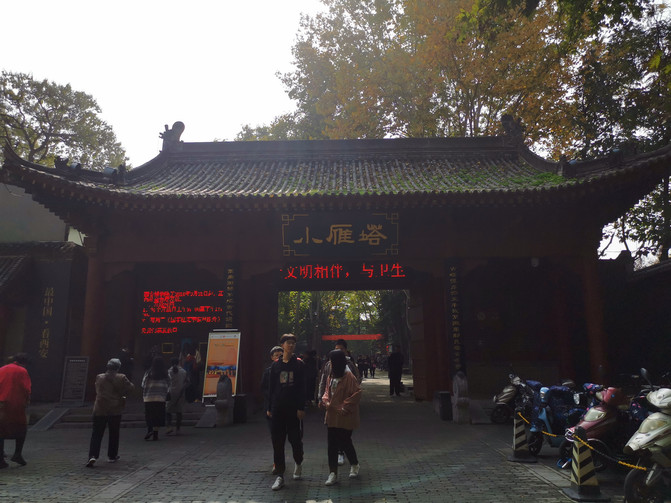





The Little Wild Goose Pagoda was built during the Jinglong period of the Tang Dynasty (707 AD) to accommodate the "eminent monk Yijing" who returned from India to translate Buddhist scriptures. When it was first built, it had 15 floors. After encountering many earthquakes, only 13 floors are now available. There are wooden ladders inside the tower, which spiral upwards to reach the top of the tower.






Jianfu Temple, where the Little Wild Goose Pagoda is located, is full of ginkgo trees, which is very beautiful.




The Little Wild Goose Pagoda came out to be the Xi'an Museum, but there was nothing in the museum, unfortunately.




The museum came out and planned to visit the ancient city wall and take the subway to Yongning Gate.



There are currently 18 city gates in the Xi'an City Wall, clockwise starting from Yongning Gate: Yongning Gate, Zhuque Gate, Wumu Gate, Hanguang Gate, Anding Gate, Yuxiang Gate, Shangwu Gate, Anyuan Gate, Shangde Gate, Jiefang Gate, Shangjian Gate, Shangqin Gate, Chaoyang Gate, Zhongshanmen, Changle Gate, Jianguo Gate, Hepingmen, and Wenchang Gate. Among them, only Yongning Gate had three city walls intact. This was because of the need for military defense at that time. Due to the long history of Anyuan Gate, Changle Gate, and Anding Gate, only two city walls were left. The door openings beside the city wall were all built during the Republic of China. The remaining 14 gates were built in a later stage.


We also happened to encounter a soldier changing of the guard performance.
The ancient city wall is about 14 kilometers long. It was built on the basis of the imperial city of the Tang Dynasty, including a series of facilities such as a moat and corner towers. The existing city wall is a Ming Dynasty building with a total length of 13.7 kilometers. It was built in the third year of Hongwu, Taizu of the Ming Dynasty (1370), completed in the 11th year of Hongwu (1378).
The buildings on the city wall are divided into: enemy towers, main towers, arrow towers, gate towers and corner towers.











A tandem bicycle is 90 yuan/180 minutes. My husband and I rented one. Just remember the past. The city wall seems to be a barrier separating modern civilization from ancient civilization. Riding on it makes me feel trance!


After returning the car, I finally waited until the sun set and the lanterns lit up. It was like dreaming of returning to the Tang Dynasty.











Satisfied to come down from the city wall and find food. It is opposite the bell tower-Chang 'an for boiling wine.


The viewing seat was specially selected

Huangguichou Liquor

Southern Shaanxi Stripe Pork
If this pork strip meets the jar meat from Harbin Daowai Casserole Shop, it will be taught.

Old flavor roasted three delicacies

drying clothes and tripe
The tripe is still traditional and serious tripe, but the sauce is more naughty.

Chang 'an Qiangguo Old Tofu

Ice cream glutinous rice

Laoshan Youbing
This small cake is crispy, and eating it with the ingredients can satisfy your cravings and boredom.

Yellow beef with mixed fungi
Day 9 [November 3] Return to Harbin
We ate roujiamo and spicy soup in the morning, and rested until 2 p.m. to check out. The flight was originally after 5 o'clock, but it was delayed until 7 o'clock. The four of us made it home with a roujiamo and a bowl of instant noodles.


The collision of Chengdu and Xi'an ~ A journey of food and culture ~ Stop here!
Previous Article:Visiting relatives in the ancient capital of the thirteen dynasties, I regret leaving next time!!!
Next Article:Xi'an to Xinjiang 18 days and 10 flights to northern and southern Xinjiang leisure tour
